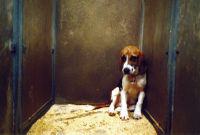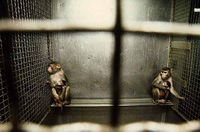NABR & the Animal Welfare Act
NABR & the Animal Welfare Act. For more general information, see also main SourceWatch article U.S. Department of Agriculture.
Contents
Overview
In 1985, amendments were introduced to the Animal Welfare Act (AWA) in the U.S. Congress, which had bipartisan support. Primary sponsors were Sen. Robert Dole (R-KS) and Rep. George Brown (D-CA). Amendments required that dogs used for research be given regular exercise and a plan for “psychological well-being” of non-human primates. Also, that every institution establish their own Institutional Animal Care and Use Committee (IACUC) to oversee and approve research and ensure compliance with federal law. Frankie Trull, president of the National Association for Biomedical Research (NABR), disputed the idea that dogs who leave their cage for exercise have better lives than those confined to cages their entire lives. According to Ms. Trull:
- “There are no scientific data which say any minimum exercise per day, or per week, is physiologically better. You just sleep better at night because you think if exercise is good for you, it must be good for the dog.” [1]
She elaborated her fear that “research institutions may be reaching the point where research will be sacrificed for economic reasons” due to excessive regulations. [2] These amendments passed. However, NABR pressured the USDA into weakening the law. According to Deborah Blum, author of "The Monkey Wars":
- "When the USDA announced that it would toughen earlier regulations, NABR filed an 118-page legal brief in opposition to the changes. After the agriculture agency backed down, issuing rules far more to the liking of the science community, Trull wrote the agriculture department a congratulatory letter, offering to provide any information needed and adding that “the association looks forward to continued cooperation with you. [3]
NABR searched for ways to weaken the simple provision that dogs be given periodic exercise. On the floor of Congress, Senator Dole expressly stated his wish that dogs be released from their cages and exercised. However, due to loopholes in the text of the AWA, NABR successfully lobbied the USDA to reinterpret the provision. That is, individually caged dogs did not have to be exercised if their cage was twice the regulation size. Also, labs that confined beagles in pairs in double cages did not have to release them for exercise. The claim was that a cage double the length of a beagle plus six inches, was room enough for exercise and the dog could be left in a cage for years at a time; only to be removed for experiments. [4] NABR also lobbied for weak interpretation of “psychological well-being” of primates. Members of Congress had consistently spoken out against cage sizes for laboratory primates (3 ft x 2 ft x 32 in.) . However, nothing changed in the USDA's final regulations except that now vivisectors could avoid even minimum regulations, if their institutional care committee approved. A lawsuit was subsequently filed and District Court Judge Charles Richey ruled in favor of animal protection organizations. The USDA and NABR appealed the ruling. Sadly, the Court of Appeals ruled that the plaintiffs lacked standing and overturned Judge Richey’s decision. The court stated that because the Animal Legal Defense Fund (ALDF) and the other plaintiffs were not themselves injured, they had no basis to sue, though the merits of their case were not disputed, [5] This is a common in animal litigation.
Senator John Melcher, a veterinarian and the legislator responsible for the amendment requiring psychological well-being of primates, expressed disappointment that so many primates continued to be housed in tiny stainless steel boxes their entire lives, deprived of enrichment and socialization. [6] In 1999, the Alternative Research and Development Foundation filed suit against the USDA to force them to regulate research on rats, mice and birds. The USDA filed a motion to dismiss, which failed. The USDA agreed to revisit their rules regarding rats, mice and birds and begin overseeing their treatment. Incredibly, NABR attempted file a third party motion to vacate the agreement between the USDA and ARDF. The Court of Appeals ruled that NABR had no basis for a lawsuit. [7] The decision meant that the USDA would go forward with plans to cover rats, mice and birds under the AWA. The prospect of having 95% of laboratory animals with the slightest legal protection, put the vivisection industry into an uproar.
- “What are they thinking?” Exclaimed an angry Frankie Trull
The Association for American Medical Colleges also expressed their “disappointment.” [8]
NABR & the Helms amendment
NABR immediately fell into action to find another means of excluding rats, mice and birds from the AWA. First, lobbyists persuaded Congress to put off protecting mice and rats for another year. During this time, an undercover PETA investigation documented horrific abuses to rats and mice and University of North Carolina, Chapel Hill. Undercover footage showed fully conscious rats being crudely beheaded with scissors. [9] Never-the-less, NABR successfully got Senator Jesse Helms (R-NC) to introduce an amendment, defining “animal” to explicitly exclude rats, mice, and birds. The amendment was attached to a massive farm subsidy bill without any debate. This was a political trick which forced any opposition to vote against a popular farm subsidy amendment. Senator Helms managed to have the bill become law without a vote in the House because Congress decided the amendment was too insubstantial to justify it. [10] See also U.S. animal rights legislation.
USDA inspections
USDA-APHIS AWA reports & facility information
The USDA Animal & Plant Health Inspection Service/Animal Care (USDA/APHIS/AC) is responsible for inspections, reporting and enforcing the Animal Welfare Act (AWA). The AWA is the only federal law that regulates animals bred and sold by dealers, animals in entertainment, zoo animals and laboratory animals. [11]
Breeders, dealers, exhibitors, handlers & laboratories
As of May 26, 2009, the USDA began posting all inspection reports for animal breeders, dealers, exhibitors, handlers, research facilities and animal carriers by state. See also USDA Animal Welfare Inspection Reports.
Articles & sources
SourceWatch articles
- Animal Enterprise Terrorism Act
- Animal testing
- Frankie Trull
- Humane Movement
- Foundation for Biomedical Research
- National Association for Biomedical Research
- Petland
- Policy Directions Inc.
- Puppy Mills
- U.S. Global Exotics
- U.S. Government's War on Animals
- War on Animals
- U.S. Department of Agriculture
References
- ↑ Jim Drinkard AP Newsfeatures, Associated Press, April 6, 1986
- ↑ Laboratory Primate Newsletter, Volume 25 No. 3, JULY 1986
- ↑ Deborah Blum The Monkey Wars, December, 1995, p. 147, ISBN-13: 978-0195101096
- ↑ Janice C. Swanson, Ph.D.Exercise for Dogs, U.S. Department of Agriculture National Agricultural Library, January 1979 - October 1991
- ↑ Animal Legal Defense Fund v. Espy, 29 F.3d 720 (1994)]
- ↑ Sen. John Melcher The Mental Health of Primates; We’re Still Needlessly Cruel to Research Animals in Our Labs, The Washington Post, September 1991
- ↑ Alternative Research and Development Foundation v. Veneman, 262 F.3d 406. DC Cir (2001).
- ↑ Washington Post, October 3, 2000
- ↑ Rick Weiss Lab animal abuses caught on PETA tape: Group circulates spy video to Congress, Washington Post, April 2002
- ↑ Jeremy Beckham Vivisectors and Robber Barons, PrimateLabs.com, accessed October 2009
- ↑ Animal Welfare Act and Regulations, USDA, May 2009


